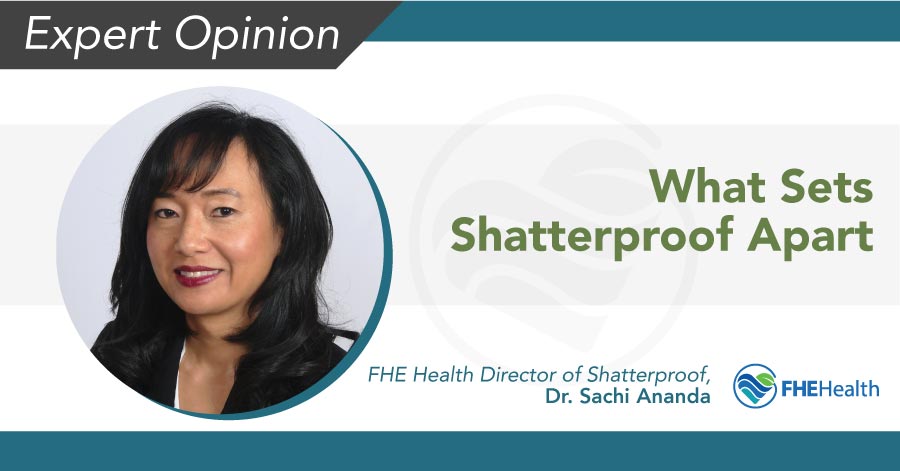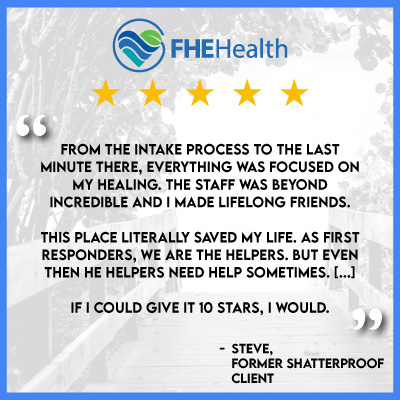
This article has been reviewed for accuracy by our peer review team which includes clinicians and medical professionals. Learn more about our peer review process.
Shatterproof FHE Health is a specialized addiction and mental health treatment program for first responders. Its treatments, therapies, and supports are designed to address the unique needs of the men and women, who routinely face crises, danger, and trauma in their job as public servants.
What, specifically, sets Shatterproof at FHE Health apart? We put this question before Sachi Ananda, Ph.D., LMHC, MCAP. Dr. Ananda is Program Director of Shatterproof FHE Health. She is also an expert on trauma and a clinician specializing in trauma and relationship therapy.
In a recent interview, Dr. Ananda spoke about aspects of Shatterproof FHE Health that set it apart, from peer support groups and intensive trauma therapy to the structure of a typical day in the program. All these elements seek to address the unique mental health and addiction treatment needs of first responders….
“You will not find another treatment center for first responders that offers as many treatment modalities in one location as the Shatterproof program at FHE Health.” – Eric, Former patient in Shatterproof
First Responder Mental Health and Addiction Treatment Needs
Only a fraction of the 60 percent of first responders who report mental health needs seek treatment, Dr. Ananda said, citing a 2021 study in the International Journal of Environmental Research and Public Health. Yet constant exposure to trauma takes a toll on anyone; and, unlike most people who may be able to recall one or two traumatic experiences in a lifetime, firefighters, law enforcement officers, and other emergency personnel face chronic exposure to trauma.
Stats on First Responder Mental Health and Addiction
That accumulated trauma helps to explain statistics like the following:
- 1 in 3 first responders (firefighters, paramedics, and police officers) will develop PTSD, according to the Substance Abuse and Mental Health Administration (SAMHSA).
- Alcohol abuse affects as many as 29 percent of firefighters, and prescription drug abuse may affect 10 percent of firefighters, the National Survey on Drug Use and Health revealed. Rates of substance abuse are elevated among other first responders, too. For instance, one in four police officers has a drug or alcohol problem.
- More first responders die from suicide than in the line of duty, according to a 2021 Centers for Disease Control report. The same report, “Suicides Among First Responders: A Call to Action,” attributed the higher risk of suicide among first responders to “the environments in which they work, their culture, and stress, both occupational and personal.”
Why Is Peer Support Important in First Responder Treatment?
“Peer support” groups with other first responders who share the same culture is therefore a core feature of Shatterproof FHE Health that also sets it apart. We asked Dr. Ananda why this element of the program is important in first responder treatment. Here is what she said:
While working on the job, first responders often have to work together within their departments, teams, and units. Their lives may depend on how well they work with each other. The deep level of trust that’s required on the job spills over to their personal lives, where they tend to only trust those who have the lived experience of being a first responder. That’s why peer support is so important—because when first responders are struggling, they are more likely to open up to their peers rather than professionals or outsiders.
Dr. Ananda isn’t just speaking from her own experience as a trauma therapist who works closely with first responders. Research confirms that social support from other first responders fulfills a key therapeutic function and can serve as a protective buffer from the mental health effects of occupational stress and trauma.
“I went to the Shatterproof first responder program for 28 days … after the absolute lowest point in my life. From the intake process to the last minute there, everything was focused on my healing … This place literally saved my life.” – Steve, Former patient in Shatterproof FHE Health
Intensive Trauma Therapy: “Eye Movement Desensitization and Reprocessing” (EMDR)
EMDR (“Eye Movement Desensitization and Reprocessing”) is an evidence-based practice that helps to provide rapid symptom relief from trauma. Intensive EMDR therapy involves extended therapy sessions that allow for a more immersive and concentrated healing experience. In Shatterproof, these sessions are 90 minutes, and each patient receives two sessions or more as needed.
“Intensive EMDR therapy is particularly good for first responders, because even just a few sessions can significantly reduce distress from trauma,” Dr. Ananda said. “This helps first responders find relief faster, recover more quickly, and get back to serving their communities as soon as possible.”
Neuroscience-Based Treatments That Restore Brain Health
Neuroscience-based treatments like neurostimulation can target areas of dysfunction in the brain for deeper, faster healing, by working with and leveraging the brain’s innate ability to heal itself. The process starts with an EEG brain map or “visual representation of the brain affected by PTSD,” Dr. Ananda said.
“Many first responders may feel guilt and shame to have to go to treatment because they view it as a sign of weakness,” Dr. Ananda continued. “But the neuro mapping shows how chronic exposure to stress has damaged the brain’s functioning, which negatively affects mental health and wellness.”
Non-invasive treatments such as neurostimulation can help to balance and improve brain function, so that first responders can get better sleep, think clearly, and be able to manage daily stress on the job, Dr. Ananda said.
“In my time there, FHE Health not just helped me overcome PTSD but gave me the fortitude and skills needed to help myself out of bad times when they do arise.” – Hyane, Former patient in Shatterproof FHE Health
Common Feedback from First Responders in Shatterproof FHE Health
 Feedback from patients about their experience in Shatterproof FHE Health is another way to explore the unique dimensions of this program. One comment that Dr. Ananda hears the most: “This program saved my life.”
Feedback from patients about their experience in Shatterproof FHE Health is another way to explore the unique dimensions of this program. One comment that Dr. Ananda hears the most: “This program saved my life.”
Hearing that “keeps fueling the fire for me to continue as program director,” Dr. Ananda said. She went on to explain why this remark is especially eye-opening and carries more weight coming from a first responder:
First responders are trained to be on alert for people and places that are potentially dangerous or life threatening. They take this trained eye to treatment programs, and so as clients going into programs, they are known to be much more distrustful, cautious, and skeptical. If they say they love the program and that it has helped save first responders’ lives, they mean it.
Dr. Ananda added that patients “often say it’s not like any other first responder program or general population program in the country.”
What Is a Typical Day Like in Shatterproof FHE Health?
Many patients begin their day with exercise or a walk around the campus with others in the program, Dr. Ananda said. Breakfast, a “a community meal” like lunch and dinner, follows.
After that, patients participate in “trauma-focused therapeutic groups in the mornings and afternoons.” These groups “range from first responder-specific psychoeducation to group processing and expressive healing therapies.”
Meanwhile, throughout the day, patients are also:
- meeting with therapists, medical/psychiatric teams, care coordinators, and other staff to assist with various issues
- receiving cutting-edge neuro rehab services to help heal the brain faster from damage caused by chronic exposure to trauma
- receiving other therapeutic services like biofeedback bed, massage, and acupuncture
There is also an exclusive time reserved for first responders only to use the FHE Health gym, Dr. Ananda said. She explained that the evenings are typically when peer recovery support groups meet.
“The day ends with more community bonding and peer support in the form of community barbecues and dinners,” Dr. Ananda said.
What to Know if You’re on the Fence About Treatment
It’s not uncommon for first responders who are struggling with a mental health issue or substance abuse problem to feel hesitant about reaching out for help. Whether because of fears about job security, worries about stigma and appearing “weak,” or other anxieties, many first responders do not reach out for help and suffer needlessly in silence.
For these first responders, what message would Dr. Ananda most want to convey?
“First responders dedicate their lives to helping others, so it’s a foreign concept for them to put themselves before others,” she said. “There is no shame in asking for help, because sometimes rescuers need to be rescued, too.”
More Resources And Support For First Responder Heroes:
- 7 Reasons First Responders Need Specialized Mental Health Treatment and Support
- The Real Dangers of Fentanyl Exposure for First Responders
- First Responder Mental Health at Heart of New Partnership
- 5 Ways to Show Support for First Responders on the 20th Anniversary of 9/11
- Our Shatterproof FHE Health Program






